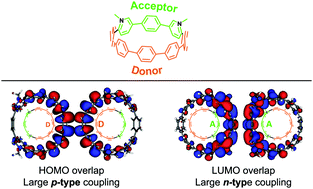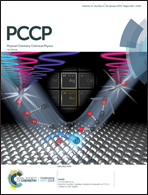Charge transport parameters for carbon based nanohoops and donor–acceptor derivatives†
Abstract
The effect of donor–acceptor (D–A) moieties on magnitudes such as reorganization energies and electronic couplings in cycloparaphenylene (CPP) carbon based nanohoops (i.e. conjugated organic molecules with cyclic topology) is highlighted via model computations and analysis of the available crystalline structure of N,N-dimethylaza[8]CPP. For the sake of comparison, intra-molecular and inter-molecular charge transport parameters are concomitantly modelled for the recently determined herringbone polymorph of [6]CPP, along with [8]CPP and [12]CPP. The peculiar contribution of low frequency vibrations to intramolecular reorganization energies is also disclosed by computing the Huang–Rhys factors for the investigated [n]CPPs and the N,N-dimethylaza derivative. In contrast with most planar organic semiconductors where the layer in which molecules are herringbone arranged identifies the high-mobility plane, nanohoops disclose inter-layer electronic couplings larger than the intra-layer counterparts. Charge transfer rate constants modelled with three different approaches (Marcus, Marcus–Levich–Jortner and spectral overlap) suggest that D–A nanohoops, owing to orbital localization, may be more efficient for charge transport than [n]CPPs for suitable solid phase arrangements.



 Please wait while we load your content...
Please wait while we load your content...